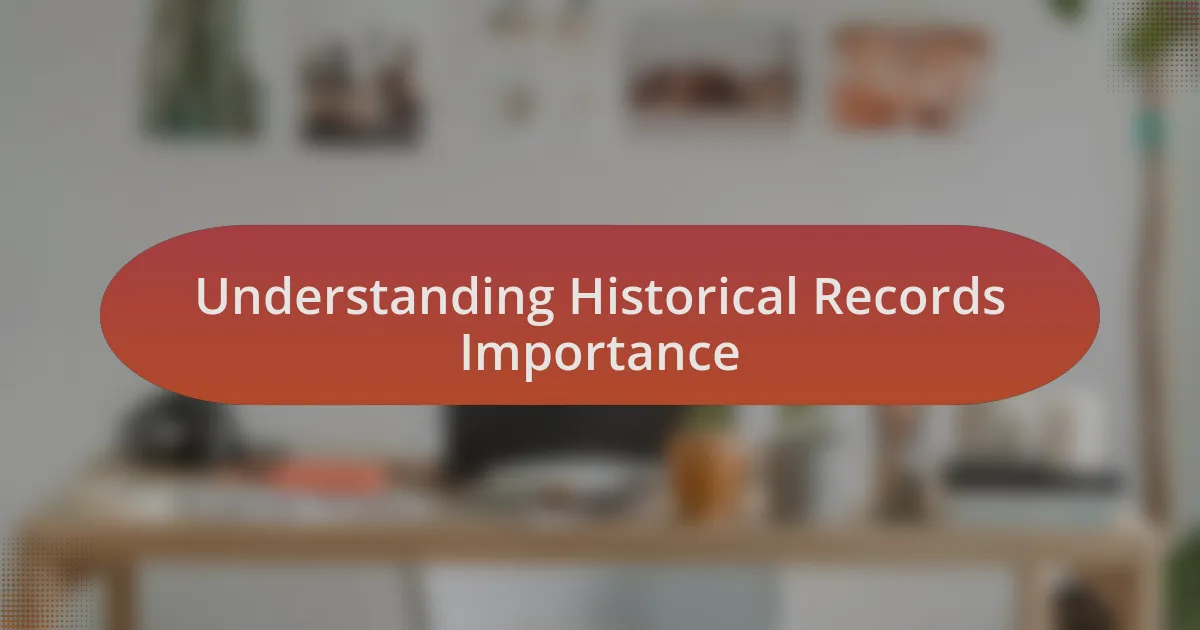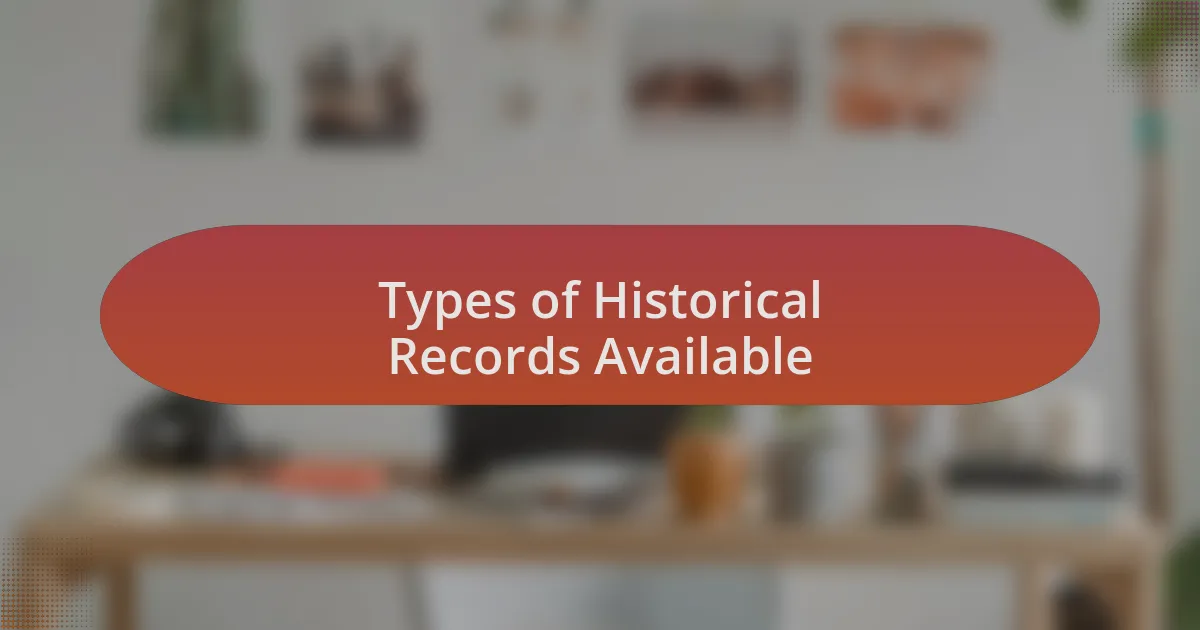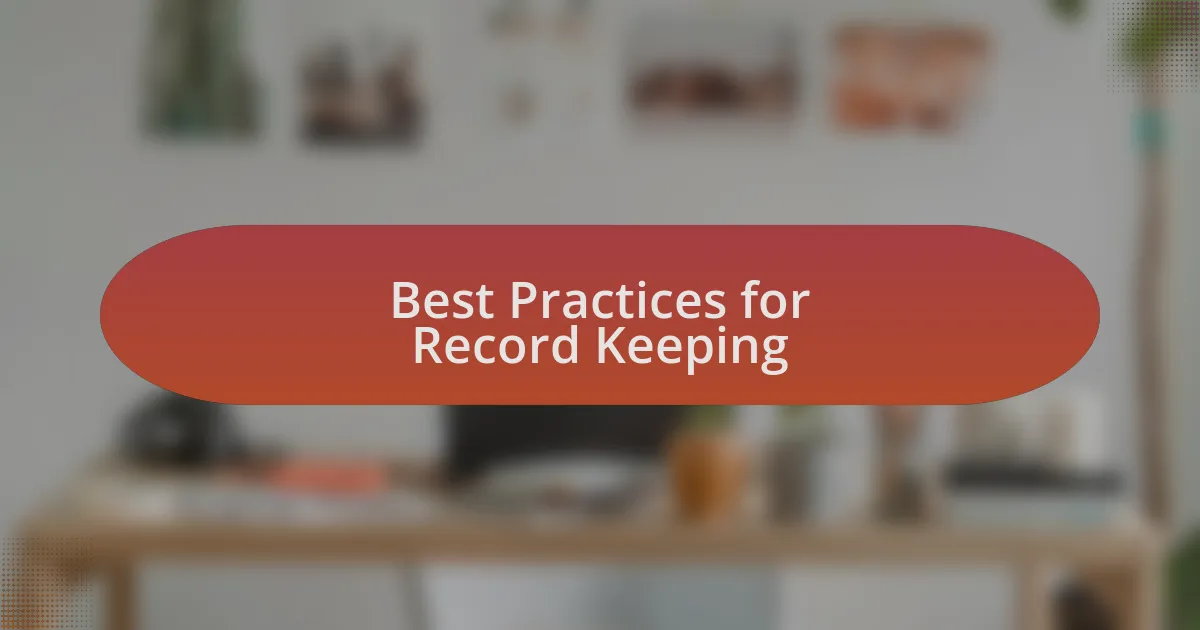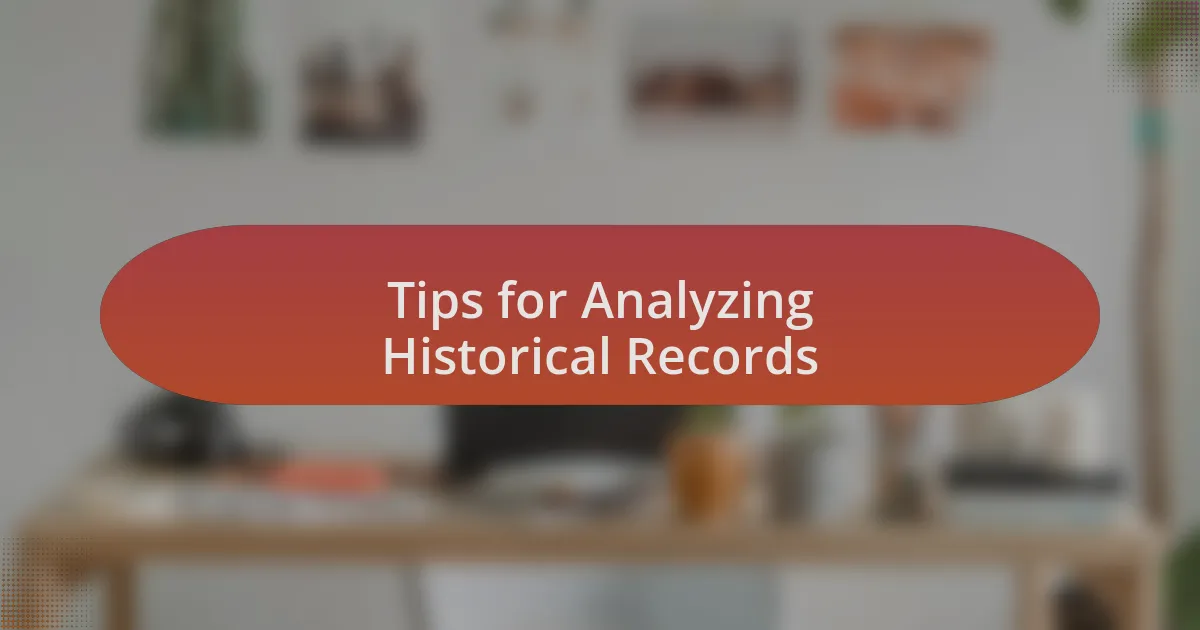Key takeaways:
- Historical records provide profound connections to our ancestors, revealing their lives and societal changes through vital records, census data, and military documents.
- Accessing these records can be simplified through local libraries, online databases, and local archives, enhancing personal understanding of family history.
- Organizing and analyzing records is crucial, with practices like labeling documents and collaborating with others enriching the research experience.
- Engaging deeply with historical documents can reshape perspectives on family narratives, emphasizing patience, context, and the importance of sharing findings with relatives.

Understanding Historical Records Importance
When I first delved into historical records, I was struck by how they can bring our ancestors to life. The dusty old documents in the archives seemed to whisper stories of love, hardship, and resilience. Have you ever felt that connection to your past? It’s as if each record unlocks a door to a different world where our ancestors navigated their own challenges.
Understanding the importance of these records goes beyond mere curiosity; it’s about piecing together a family legacy. I remember stumbling upon a marriage certificate that not only confirmed a relationship but revealed the intertwined lives of my great-grandparents. It made me wonder—what would my life be like if they hadn’t made the choices they did? This perspective adds a profound layer to my appreciation of family history.
Moreover, historical records are essential for understanding societal changes and the broader context of our ancestors’ lives. The more I explored census data and immigration records, the more I realized how external events shaped individual stories. Isn’t it fascinating how one record can illuminate not just a family’s journey, but also reflect the larger tapestry of history? It’s all interconnected, and that realization makes researching familial ties incredibly rewarding.

Types of Historical Records Available
When exploring the types of historical records available, one quickly encounters vital records, which include birth, marriage, and death certificates. These documents not only mark significant life events but also capture familial connections. I recall unearthing my grandmother’s birth certificate; it provided not just her name but a glimpse into the world she was born into. How can such a simple piece of paper hold so much meaning?
Census records are another treasure trove. They offer snapshots of families at different points in time, revealing not just household compositions but also where they lived and their occupations. I vividly remember poring over a census from the early 1900s, amazed to see my great-grandparents listed with their children. It was like meeting them all over again—can you imagine the stories they would tell?
Then there are military records, which pull back the curtain on the sacrifices made by our ancestors. I discovered a service record for a distant uncle who fought in World War I. His bravery and struggles, documented in faded ink, made my heart swell with pride. How could anyone not feel a profound sense of connection when faced with such a testament to resilience and courage?

How to Access Historical Records
Accessing historical records can seem daunting at first, but several avenues can simplify the process. I remember my initial search at a local library; they had a dedicated genealogy section packed with resources and knowledgeable staff ready to assist. Such places can become hubs of unexpected discoveries, don’t you think?
Online databases have revolutionized how we access historical records today. I often find myself diving into websites like Ancestry or FamilySearch, where millions of documents are just a click away. The thrill I felt when I stumbled upon a scanned photograph of my great-great-grandparents was unforgettable—how could a single image bridge so many years?
Local archives also hold a wealth of information waiting to be uncovered. I recall the excitement of visiting my town’s historical society, where I found land deeds that traced my family’s settlement in the area. Each record was like a chapter in my family’s story, revealing connections I never knew existed. Isn’t it fascinating how tracing back through these records can illuminate our understanding of both personal and collective histories?

Best Practices for Record Keeping
Keeping organized records is essential in genealogy. When I started gathering information, I quickly learned the importance of a system that works for you. Whether it’s a digital format or good old-fashioned paper folders, maintaining careful organization allows you to track your sources accurately, helping avoid the frustration I faced when I couldn’t remember where I found a vital document.
I also discovered that consistently labeling documents is a game changer. The first time I found an ancestor’s birth certificate, I was thrilled until I realized I hadn’t noted where I had saved it. Now, I diligently include the source and date when I add a record. This practice not only saves time but also enhances the reliability of the family tree you’re building. Isn’t it amazing how a little detail can prevent so much confusion later?
Lastly, I recommend setting aside regular time for record keeping. Life can get busy, but I always try to dedicate an hour each week to review and update my findings. This routine not only keeps me on track but also rekindles my excitement as I often stumble upon new records or insights that propel my research forward. Have you carved out time for your genealogy journey? Taking that step can truly deepen your understanding of your family’s history.

Tips for Analyzing Historical Records
Analyzing historical records can be a thrilling yet daunting task. When I first encountered a collection of census records, I was overwhelmed by the sheer volume of information. To make sense of it all, I started creating a spreadsheet where I could jot down key details like names, ages, and relationships. This method not only clarified my findings but also revealed patterns and connections I might have otherwise missed. Do you have a system for organizing your discoveries?
Context is everything when interpreting historical documents. One time, I stumbled upon a marriage license that listed a surprising location. Instead of dismissing it, I took the time to explore historical maps and local histories of that area. This exploration uncovered fascinating stories of migration patterns and community ties that enriched my understanding of my ancestors’ lives. Have you considered how geography could influence your family’s narrative?
Don’t underestimate the power of collaboration. I remember joining a genealogy group where members shared their experiences with interpreting old records. Hearing others’ perspectives on similar documents opened my eyes to new methods of analysis. I found that someone else’s insight could shine a light on something I had missed. Isn’t it refreshing to know that we don’t have to navigate this journey alone?

Personal Journey with Historical Records
While delving into historical records, I often find myself on a journey that feels deeply personal. A particular moment stands out: browsing through old parish registers, I uncovered a long-lost ancestor’s baptismal record. The joy I felt was palpable; it was as if I had connected with my family’s past in a tangible way. Have you ever experienced that rush when a piece of information suddenly clicks into place?
As I sifted through these records, I became increasingly aware of my ancestors’ humanity. One entry detailed a tragic note about an infant who had passed away shortly after birth. It was a stark reminder of the fragility of life and the struggles faced by families in those times. This made me ponder: what stories lie hidden behind the dry facts we often see?
Engagement with these documents can also lead to unexpected insights. I stumbled upon a series of property deeds that detailed land transfers between family members, highlighting their resilience and adaptability. Analyzing these transactions made me realize how much they fought to establish a foundation for future generations. Can you remember a time when a record changed the way you viewed your family’s journey?

Lessons Learned from My Experience
As I navigated through piles of historical documents, I learned the importance of patience. I remember a day spent meticulously sifting through dusty files, only to find a single note that explained my great-grandfather’s migration story. It struck me how sometimes, one small detail can alter our understanding of entire family narratives. Have you ever had that moment where a single record reshaped your perspective?
Another lesson emerged when I realized the significance of context. While examining military records, I encountered my great-uncle’s service history, including the challenges he faced. This wasn’t just a list of events; it transformed into a window into his world—a glimpse of bravery, fear, and sacrifice. Have you ever considered how historical context can elevate a simple fact into a profound understanding of a person’s life?
Finally, I discovered the value of sharing findings with the family. After uncovering vibrant stories about my ancestors, I organized a family gathering. Showing my relatives the records ignited passionate conversations and connections. It became clear that these documents are not merely dusty papers; they are the threads that weave our family tapestry. How could something as simple as a record inspire a deeper bond among family members?